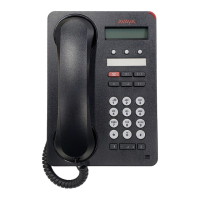Other Network Considerations
Issue 1 June 2010 25
Registration and Authentication
A 1603SW-I SIP IP Deskphone requires an outboard proxy SIP (OPS) extension on Avaya
Communication Manager and a login and password on the SM Server to register and
authenticate it. Registration is described in the Initialization process, in Step 5: Deskphone and
SIP Proxy Server on page 19. For further information, see Maintaining and Troubleshooting
Avaya Aura™ Session Manager (03-603325), available on the Avaya support Web site, http://
www.avaya.com/support and your call server administration manual.
QoS
For more information about the extent to which your network can support any or all of the QoS
initiatives, see your LAN equipment documentation. See QoS
on page 34 about QoS
implications for the 1603SW-I SIP IP Deskphones.
IEEE 802.1P and 802.1Q
For more information about IEEE 802.1P and IEEE 802.1Q and the 1603SW-I SIP IP
Deskphones, see IEEE 802.1D and 802.1Q
on page 34. Three bits of the 802.1Q tag are
reserved for identifying packet priority to allow any one of eight priorities to be assigned to a
specific packet.
● 7: Network management traffic
● 6: Voice traffic with less than 10ms latency
● 5: Voice traffic with less than 100ms latency
● 4: “Controlled-load” traffic for critical data applications
● 3: Traffic meriting “extra-effort” by the network for prompt delivery, for example, executive
e-mail
● 2: Reserved for future use
● 0: The default priority for traffic meriting the “best-effort” for prompt delivery of the network.
● 1: Background traffic such as bulk data transfers and backups
Note:
Note: Priority 0 is a higher priority than Priority 1.

